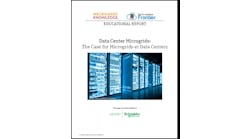Digital power yields numerous benefits in the electrical world, providing real-time information and advantages for power system design, intelligent energy storage, fast charging programs, smart cities and reliability. Tanuj Khandelwal, CTO of ETAP, explains that the move to digital power will be one of the main drivers pushing the microgrid industry forward. This interview, conducted by Elisa Wood, editor-in-chief of Microgrid Knowledge, is part of the Microgrid 2021 Executive Interview Series.
We’re seeing the microgrid industry grow very quickly, but a lot of us would like to see it grow even more quickly, especially in light of what happened, for example, in Texas, with the massive outages. What do you think needs to be done to push the industry forward?
TK: One predominant topic that comes to my mind is digital power. First, to quickly define what digital power means, it’s essentially a power supply where digital technology is used. There’s feedback in terms of controlling that supply. In other words, the digital power supply uses digital technology for the management and monitoring of the output.
The key trends in digital power are power digitalization, green energy, a tremendous boost in artificial intelligence, and simple and converging technologies. In addition, trends include comprehensive and smart energy, intelligent energy storage, fast charging, safety and reliability.
Of the many organizations that have started their digitalization journey, about 25% say they have some access to real-time data to identify anomalies, to understand the performance of their system. And about 15% or so say that they’re still at the beginning of their journey and they’re still entering data into spreadsheets in a manual manner to understand and design their systems.
The power digital transformation needs to continue being a key driver not just to digitalize information, but to use that information with the digital twin to convert the real-time information into situational intelligence.
Digital twins must become part of the electrical system design and then maintained through our commissioning and operations, and therefore you can enable a digital power system that is using digitalization at the core of it. And that is really the main driver for the industry today.
Could you give us a quick definition of digital twin?
TK: As the name suggests, it’s a digitalized replica of the physical system maintained in the digital environment. Digital twins essentially allow you to interact with the system, visualize the system and, of course, maintain the system with its actual performance virtualized in a digital environment.
It’s very similar to a pilot who learns how to fly an aircraft in a simulator — utilizing a digital twin of the electrical system to actually learn how to operate the system.
The digital twin not only gives you the ability to design, commission and operate, it also allows you to control and maintain the electrical system in a virtualized environment and understand how it’s going to respond when certain inputs are provided.
What technology shifts do you see that are helping advance the microgrid market?
TK: On the technology shift point of view, we do see digital power as the driver for the technology as well. It’s driving the industry, not just in microgrids but other segments as well.
The key technology is a digital twin-driven microgrid controller.
That’s a digital twin of the electrical system that is put together during the conceptual stage of the microgrid to do the feasibility study. The twin helps with detailed engineering, allowing you to size the electrical infrastructure while maintaining the feasibility of the original concept of the microgrid.
Once the commissioning begins, the controller that is responsible for managing the microgrid becomes part of that design and commissioning process. It’s not an afterthought that comes in at the tail end when the system is being commissioned or going online. It’s part of the evolution of the design of the system.
The way the controller behaves is known during the design stage, all the optimization is done in advance, and then we are commissioning the system. We can essentially anticipate how the system will react, making the commissioning faster, giving the customers a better understanding of the electrical system and de-risking the entire project. Then we get into operations with the same controller.
That shift from logic driven controllers to digital twin-driven controllers is one technology shift that we see.
Join ETAP at Microgrid 2021: The World Awakens to Microgrids, a virtual event conveniently offered over eight weeks, May 11-June 3 by Microgrid Knowledge. The event is designed for businesses, government agencies, institutions, municipalities and communities — or for anyone interested in learning about how a microgrid will improve their operation. Registration is free if done in advance.







